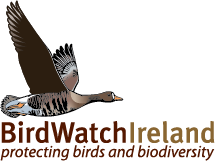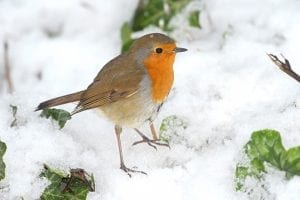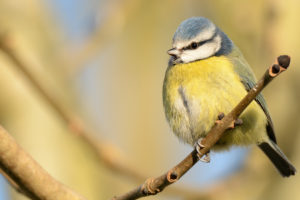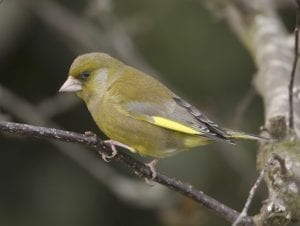BirdWatch Ireland is calling on people across the country to help monitor the health of the country’s bird populations by counting the birds visiting their garden over the winter. The Irish Garden Bird Survey, which is Ireland’s longest running and most popular ‘citizen science’ survey, will commence on Monday 1st December and run until the end of February.
Taking part in the survey is free and simple, yet has a massive impact, as all participants contribute to a crucial body of data that helps to inform monitoring and research into bird populations and environmental change.
The survey is open to all, from individuals and families to schools and nursing homes. People can participate regardless of the size of their gardens; it is a fantastic way to not only connect with local nature, but also to contribute to local conservation.
Last winter saw 1,638 gardens take part, which was the greatest number since the 2020 Covid lockdown, and BirdWatch Ireland is urging people to surpass that record and help make this winter one of the most memorable in the survey’s 37-year history.
The winter of 24/25 had its challenges in the forms of Storm Darragh and Storm Éowyn, but garden bird numbers stayed remarkably resilient. The percentage of gardens visited by the top ten species stayed more or less the same as in the previous three winters. The Robin remained on top as the most commonly recorded garden bird (present in 95% of gardens across Ireland), followed closely by the Blackbird (94%) and the Blue Tit (89%).
Robin, which topped the table once again last winter
(Photo: Richard T. Mills)
All species within the top 10 remained the same as during the previous winter; however, some rankings saw a bit of musical chairs: the Magpie climbed to 4th place, nudging the Great Tit down to 5th. Chaffinch and House Sparrow also swapped spots, with the former climbing to 6th and the latter falling to 7th. Starling edged past Goldfinch to clinch 8th place, while the small but mighty Wren remained reliably in 10th spot.
Dr. Andrew Kelly, CEO of BirdWatch Ireland, said, “All of us at BirdWatch Ireland are truly grateful to everyone who has contributed their sightings to our annual Irish Garden Bird Survey, be it last winter or at any time over the past 37 years. Their generosity and commitment have provided us with an unparalleled insight into the fortunes of Ireland’s best-loved birds, allowing us to track their ups and downs from year to year and even from decade to decade. It’s an invaluable resource that underpins our vital work as a charity to protect Ireland’s wild birds and their habitats.”
The Irish Garden Bird Survey is sponsored once again this winter by Ballymaloe, whose support in recent years has helped the survey to reach more people than ever before, improving monitoring at national level and allowing for greater focus on conservation issues facing individual species.
Maxine Hyde, General Manager at Ballymaloe Foods, said, “At Ballymaloe, we recognise the vital role that birds play in our ecosystems and the joy they bring to our lives. Supporting this incredibly important survey is our way of contributing to the understanding and conservation of these birds. We are thrilled to be part of this initiative, encouraging everyone to observe and appreciate the beauty of wildlife in their own gardens.”
Blue Tit: a perennial favourite with Irish Garden Bird Survey participants
(Photo: Brian Burke)
“We’ve had many calls and emails since September from people worried that their usual garden visitors – particularly Robins, Blackbirds and House Sparrows – seem to be missing,” said Aisling Kinsella, the new coordinator of the Irish Garden Bird Survey. “I want to reassure everyone that this is perfectly normal for that time of year. After the breeding season, birds are moulting, and there’s plenty of natural food sources available in the countryside, so they spend less time in gardens. But, over the past couple of weeks, temperatures have dropped and much of the country has been covered in frost and snow. As natural food supplies decrease, we expect to see these birds, and others, returning to gardens and feeders: just in time for this winter’s survey.”
Bird ‘flu is currently spreading through Europe, and Ireland is no exception. BirdWatch Ireland would like to reassure people that the risk of this disease hitting garden birds is low. Even though we are currently seeing outbreaks in poultry farms across the country, in wild birds the virus predominantly affects seabirds and waterbirds, which is reflective of recent records of dead gulls and swans. There is minimal interaction between these species and garden birds, so it is unlikely bird ‘flu will be brought into gardens.
“I understand that people are worried for the birds, and potentially for themselves, but it is highly unlikely that your garden birds will be carrying bird ‘flu,” said Aisling Kinsella. “If you see a sick bird in your garden, chances are it is suffering from trichomoniasis, which is harmless to humans, rather than bird ‘flu. Ensuring that garden feeders are cleaned frequently and thoroughly is key to helping to limit the spread of this disease.
“Our Irish Garden Bird Survey form has a section for you to record sick and dead birds and I would encourage people to fill this out, if at all possible. The BirdWatch Ireland website also has guidance on what to do if you see a sick or dead bird in your garden.”
Greenfinches appear to be the species worst affected by trichomoniasis at present, with Irish Garden Bird Survey data showing that there was a decrease of more than 30% in garden visits by these colourful members of the finch family during winter 24/25 compared to 10 years ago.
Greenfinch: a frequent victim of trichomoniasis
(Photo: David Dillon)
The Irish Garden Bird Survey would not be entering its 37th year without the dedication and passion of members of the public. Everyone who takes part is helping to protect local biodiversity. Garden birds provide valuable clues about the health of our wider ecosystems, so every participating garden makes a difference. All you need to take part is a little bit of time each week to watch your garden birds. If you don’t have a garden, a balcony or a shared community space works too. So tell your family, a friend or a neighbour – and be part of BirdWatch Ireland’s largest citizen science survey together.
To learn more about the survey and to get involved, please click here.





